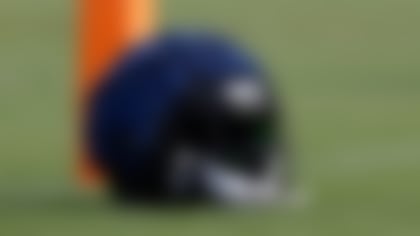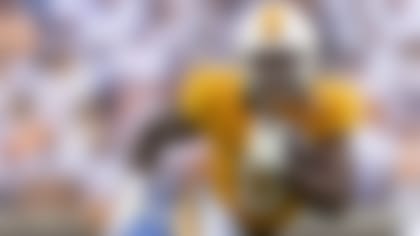INDIANAPOLIS -- The prospective NFL offensive linemen moved about the media circuit at the combine Thursday at Lucas Oil Stadium following extensive medical workups. Most looked the part, strolling around in black sweats, meeting media that probed which teams the players will be meeting with before going through a multitude of drills in the coming days.
Yet, this whole circuit might not dictate much of what teams -- especially those in desperate need -- are looking for in an offensive lineman.
"Toughness," Dolphins coach Tony Sparano said about the main trait he wants in an offensive lineman.
Can't measure that in a 40-yard dash or in drills where guys go at it in non-padded Under Armour gear. You can measure it, though, but it might take the insight of an offensive line coach, by nature, like Sparano.
"It's OK to watch them against the best player, but I kind of like to watch them against people they should play well against and see maybe what they're about," Sparano said.
Manhandling the vulnerable measures a player's focus, will and, maybe, his nasty streak -- requirements that are mandatory in the NFL, where there are no patsies eager to make their mark by racking up quarterback sacks and tackles for lost yardage.
Sparano, along with members of Miami's personnel staff, saw what he liked in Michigan tackle Jake Long and used the NFL draft's No. 1 pick on him last season. Though a lot of other things fell in place, Long's development at left tackle factored into the Dolphins advancing to the playoffs after winning just one game the season before he was drafted.
As a result, Miami will select 25th overall in April's draft, long after most of the top offensive line prospects have been snatched up.
Tackles Andre Smith (Alabama), Eugene Monroe (Virginia), Jason Smith (Baylor) and Michael Oher (Mississippi) and centers Alex Mack (California) and Max Unger (Oregon) lead an offensive line group that is highly regarded for its depth and top-end talent, especially at tackle. The guard group isn't viewed as spectacular, but solid players can be found (isn't that what is always said about guards?).
"We coached in the Senior Bowl last year, and you had a pretty good idea about both (teams') lines," Raiders coach Tom Cable said about the offensive line prospects in the 2008 draft class. "This year, just going to the Senior Bowl and watching, I thought all these guys are going to be NFL players. I wasn't sure about all those guys last year."
Most of the teams in the top 10 of the draft need to upgrade their offensive lines with top-level players (St. Louis, Cincinnati and Jacksonville, especially), and some of them will. The run on tackles could start much earlier than last season, when six went in the top 19 picks. There might not be as many tackles selected, but the top four could be gone before the 15th selection.
The projected first-round picks among the offensive linemen have the size, footwork, strength and athleticism to be anchors for years. Yet, do they have that extra bit of heart that will let them overcome being whipped by Pittsburgh linebacker James Harrison on the previous play? Do they possess that extra toughness to move Albert Haynesworth back a yard at money time after being hammered for the better part of four quarters?
That's what differentiates guys who make it to the NFL and those who make it through the NFL.
Like Sparano, Cable is a longtime offensive line coach. He's a bear of a man who can stand toe-to-toe with any of his linemen who dare challenge him. In fact, that's what he wants to see out of any lineman entrusted to create holes for running backs Justin Fargas and Darren McFadden, and whose job it is to give quarterback JaMarcus Russell some time to throw.
Finding offensive linemen who possess the gumption to pummel 'til they puke are The Cable Guy's kind of guys.
"People talk about toughness, but I don't think you get here without having a certain level of toughness," Cable said. "What I want to find out is, does he know how to strain himself? Can he push himself further than most so you can push him even further? Most people can't do that. Most of us won't do that. You find the ones who can, and the ones who are willing to, and they're probably going to be pretty good, regardless of when you pick them."
Cable said you can find those special players by watching film, or in person, and determining: "Can he still play as hard and as fast at the end of practice as he did at the beginning. Or play as hard at the end of the game as he did at the beginning? Can he do it while he's hurting? Can he do it while you're down by three touchdowns? Can he strain when most humans won't do that."
Durability also is a tool used by teams when it comes to drafting linemen. If someone is a one-year starter, he will come under a lot more scrutiny. Was there a stud in front of him for a few years or did the player just not work hard enough to crack the starting lineup? Was the player routinely hurt or did he change positions?
"You're looking for the guy that maybe was the three-, four-year starter, that's got maybe 30 or 40 starts under his belt," Sparano said. "You've got to be a little bit careful and really do your homework on the one- or two-year guys. I want to see the guy that's had 47 starts in college. That leads you to believe he's going to be a pretty durable starter for you."
Playing along the line of scrimmage requires a certain set of survival skills that typically require good technique, acumen and strength at the outset of a play and utter ruthlessness the rest of the way.
Virginia's Monroe said his tangibles have proven true through his body of work. He was so good that last season's No. 15 overall pick, Branden Albert, had to spend most of his career at Virginia playing guard because he couldn't unseat Monroe. Albert started 15 games at left tackle for the Kansas City Chiefs, a sign that Monroe was a pretty special player in college.
Monroe said he can play in any kind of system, be it a zone-blocking scheme that lends itself to cut blocking, or a standard man, in-line blocking scheme, or even a hybrid spread set.
"We did just about everything at UVa," Monroe said.
What he can't wait to show teams at the combine is that hard-to-measure element that usually is conveyed on fourth-and-inches but can also be presented during sit-down interviews with coaches and personnel types, who ask questions like, "If you pancake the guy in front of you, would you help him up -- and why?"
"For me, the most important thing is meeting with the teams in these interviews and letting them have an understanding of who I am and a few of the things I know," Monroe said. "They need to familiarize themselves with me because they're here to draft a football player, not a workout animal."




